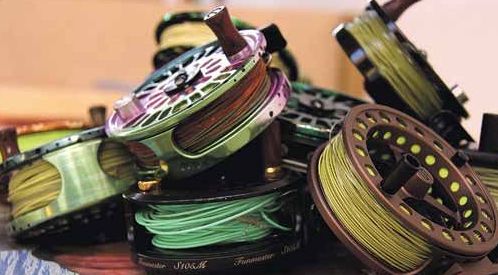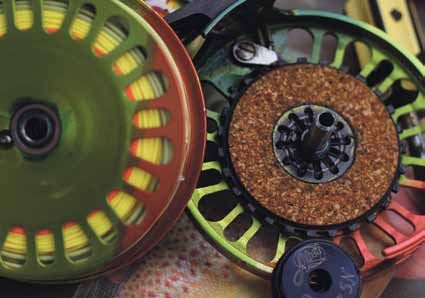 Presented from Issue 99
Presented from Issue 99
I have something to confess, I am a tackle junkie. When it comes to fly fishing gear I try and collect whatever I can, whenever I can. Doesn’t make me very popular at times I must admit but I’m afraid that is just the way it is. My current passion is for collecting different styles of chest/vest packs but I do have a soft spot for a nice reel. A fly reel is probably more important to our kit than a pack lets be honest, you can always throw a box of flies in your pocket if needed and go fishing. But if there is no fly reel locked on to the end of your favourite rod its going to be a tough day on the water!. Over the years I have collected and gotten rid of a fair few fly reels. Some brilliant, some pretty ordinary to tell you the truth.
With so many different choices available we will concentrate mainly on the freshwater side of things for this article. It can at times be a bit daunting, especially for those just starting out on their fly- fishing journey. What type of arbor, drag style, drag material, reel construction, types of finish etc. can all lead to an easy choice being a somewhat difficult one. I certainly don’t claim to be an expert in the workings of every fly reel, but hopefully my experiences may help you to decide which reel might best be suited for you and your intended types of fishing. So let’s have a look at what is available.
Standard vs Large Arbor
Fly reels are essentially quite a basic piece of engineering. Throw a line holding spool onto a spindle so it can rotate, whack a handle on to help control the rotation and there you have it, your fly reel is right to use. Whilst that is not exactly how easy it is, I mean no disrespect to the reel manufacturers out there, I am sure you get the point. Since 1874 when Charles Orvis put a patent on the first American fly reel of this style things haven’t really changed a lot. Sure we have seen changes such as palming rims, drag materials and the obvious ones like better materials and more advanced machining capabilities over the course of time. It is my opinion that the most important advancement in the manufacture of fly reels has been the introduction of the large arbor. The arbor on a fly reel is essentially the inside diameter of your spool. Therefore the larger that diameter is the larger your inner wraps of backing will be. The benefits of using a large arbor reel over a standard arbor can be improved rate of line retrieval.
When writing this story I did a bit of measuring on a couple of my reels to suit around a 5 weight fly line. One full rev on my standard arbor empty reel retrieved around 40mm of line whilst the same thing on the large arbor reel brought in around about 210mm, so you can see that is a difference of around 500%. When you have a full fly-line out and an angry brown trout tail walking around the lake that can make a fair bit to difference to whether your battle is successful or not.
Another consideration for line retrieval is the amount of times a fly-fisher will strip long lengths of line of his reel. Whether walking your favourite shoreline or drifting in your boat we are constantly stripping off and then winding in fly-line. At the end of a long day all this cranking on your reel can leave the hands and fingers a bit sore. Again, bigger diameter equals less cranks on the handle. This is in my opinion the biggest selling point for this type of reel.
There will be less line memory due to the larger diameter of the coils of line whilst on the reel. And we all know, less tangles means happier fishing! Your reel will be doing less revs during a fight which means you will have greater control whilst palming spools etc. You will also have a slower cranking speed which can lead to less fatigue during longer fights. Admittedly this is not as important in most freshwater situations but nonetheless worth considering.
You will have a more consistent drag pressure due to the line diameter not changing as rapidly as it does on a standard arbor reel. Don’t get me wrong the standard arbor reel still has its place in fishing. For example if you are only cranking in some short lengths of line you can get the standard arbor spinning a lot quicker than the large. I still own and fish with them. I have a couple of modern standard arbor reels that I still fish with a lot and get great pleasure out of using them. Taking pride of place on the wall of my tying room is an old Hardy St. George standard arbor reel that was my Pops. I still rig it up and fish with it from time to time on my favourite spots on the Mersey river . The only downside to it is I tend to spend all day on the water thinking about Pop and how I wish he was standing in the river beside me. Not to be though, I’m afraid.
Drag types
There are two main types of drag available to users of fly reels. They are the Click and Pawl type drag, sometimes called the spring/pawl and the disc drag. The purpose of either type is to provide tension on the fly-line and to regulate how easy/ hard it is for a fish to strip line from the reel. This in turn will help to prevent fly reel overrun etc. which can lead to those day and soul destroying tangles. You will notice too that the tangles only ever happen at the wrong moment. Let’s have a look now at the pluses/minuses of each style of drag.
Click and Pawl
 Click/Pawl drags are essentially just a toothed gear in the reel that spins with the spool against a spring loaded clip or pawl. As the reel spins the pawl is dragged over the teeth of the gear. The click part of the system is purely for sound.
Click/Pawl drags are essentially just a toothed gear in the reel that spins with the spool against a spring loaded clip or pawl. As the reel spins the pawl is dragged over the teeth of the gear. The click part of the system is purely for sound.
Click/Pawl drags are ideally suited to most freshwater situations, especially where lighter tippets are being used. Line loss is very smooth with no jerkiness or variations in the line tension applied, which in turn makes the fly reel a lot better at helping to protect the tippet.Since the drag force of this style of reel is so small and in both directions these reels don’t really need to be converted from left to right hand retrieve. Though some of the current day reels do allow you to do this by rotating some lugs in the reel.
On the down side these types of reels are not designed for use on larger fish. Again in most of our freshwater situations this wont be an issue, but if you spend a lot of time chasing trophy fish it may be worth considering.
 Disc Drags
Disc Drags
The most common type of drag available in today’s modern fly reels is the draw bar disc drag. This works by compressing two or more discs together with one of them only being able to spin one way. There are other styles available but we will stick with the most common, other wise we will fill up Mikes paper!. Disc drags are designed to exert smooth but hard (if needed) pressure on the fly-line without seizing up. With disc drags you have the benefit of being able to have a lot bigger surface area. Once again this is not as important in the freshwater side of things, but if you are going to use your heavier trout rods, as many anglers do now to chase some of light saltwater species like bream and salmon for example this may well become a big factor in your decisions.
Disc drags can come in a variety of materials. Technological advances have allowed manufacturers to utilise state of the art materials like stainless steel, Teflon or rulon and even carbon fibre. But good old cork impregnated with lubricant has stood the test of time and still seems to be the most popular amongst anglers. On the down side for the trout fisherman drag tension can be more uneven which can be a problem if using light tippets for spooky fish as it can cause it to bust or “pop” as it commonly called.
What else?
I have touched on what I believe are the main factors in choosing a fly reel above, but there are some other things to consider also. What weight the reel is suited for needs considering. By this I mean line weight, not physical weight of the reel. If you choose a reel that is too small you may not be able to fit on the required backing and all your fly-line. If it is too big you will have a heap of empty space on the reel which gets back to the tangles again. Going either way will also throw out the balance of your whole outfit.
How easy can you convert the reel from left to right hand retrieve, if at all. Even though I don’t know why you would bother!. One thing I can not do is wind left handed. But whatever floats your boat, at least its good to have the option if you want to try it. The availability of spare spools can be a big factor. If you are looking at doing some competition fishing this will become even more important. Even a casual day out in the boat can be greatly improved by a few spare spools and the ability to quickly change fishing depths when required. Physical weight is also important for outfit balance and the reduction of fatigue after a long days fishing.
Still confused?
Hopefully you will now be closer to deciding which fly reel will be best for you and not even more confused. With the mechanical and physical sides of things sorted the rest is really up to personal taste and budget. What sort of look are you after in your reel with regards to porting etc. Do you want a flash looking fish graphic for your reel finish or will you be happy with good old black. Personally I am guilty of having some pretty ‘out there’ looking reels but there is a lot to be said these days for a nice plain black reel.
Tackle manufacturers now are producing a lot of good quality gear at very reasonable prices thanks to dollar conversions and the like. That favourite high end reel you have always had your eye on in the glossy magazines is now more affordable than ever. Whichever reel you choose to buy make sure you are happy with it and it suits your outfit and requirements well and your time on the water will be so much more fun. After all isn’t that why we go fishing, to have fun.
Gavin Hicks




